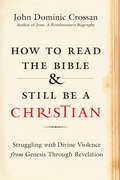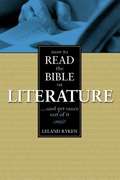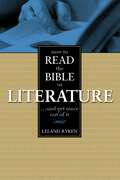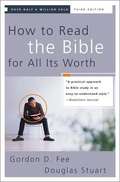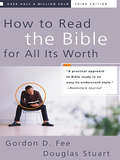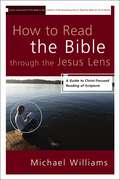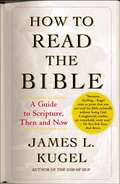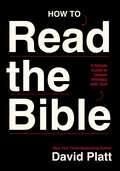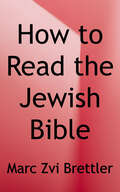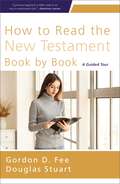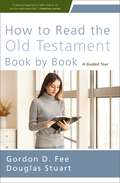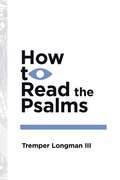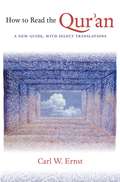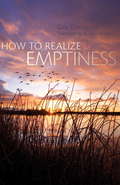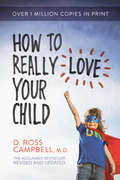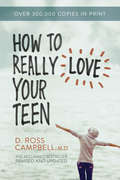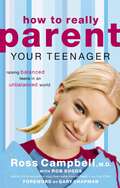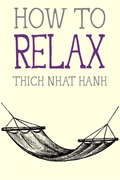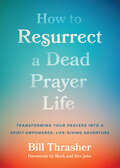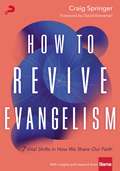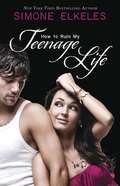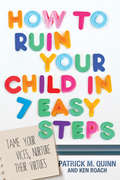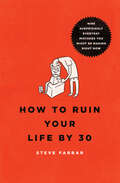- Table View
- List View
How to Read the Bible and Still Be a Christian
by John Dominic CrossanThe Bible introduces us to a loving Jesus who turns the other cheek, loves his enemies, and shows grace to all. But we also meet a warrior Jesus who leads an army of angels bent on earthly destruction. Which is the true Messiah? Should we all follow the nonviolent Jesus of the Sermon on the Mount or the vengeful, sword-wielding Christ of Revelation? As one of the foremost biblical scholars of our day, John Dominic Crossan re-veals that running throughout the entire Bible--from Genesis to Revelation--are two conflicting revelations of God: one offering a radical, holy vision where every need is provided for and love and grace are extended widely; the other working to domesticate this radical vision by em-phasizing judgment and punishment and by propping up the status quo. But one thing is clear, argues Crossan: one cannot pretend that the Bible provides a single, unified vision of God or Jesus. If one wants to discover the Bible's best and purest revelation of God, then Christians must measure the Bible by Jesus. And to find the best and purest revelation of Jesus, Crossan concludes, then we must look to the work of scholars who can point us to the teachings of the historical Jesus. Only then will we know how to read the Bible and still be a Christian.
How to Read the Bible as Literature
by Leland RykenA guide to the literary aspects of the Bible. Surveys such biblical forms as narrative or story, poetry, proverb, gospel, parable epistle, etc. Discusses the literary unity of the Bible. Copyright © Libri GmbH. All rights reserved.
How to Read the Bible as Literature: . . . and Get More Out of It
by Leland RykenWhy the Good Book Is a Great Read If you want to rightly understand the Bible, you must begin by recognizing what it is: a composite of literary styles. It is meant to be read, not just interpreted. The Bible’s truths are embedded like jewels in the rich strata of story and poetry, metaphor and proverb, parable and letter, satire and symbolism. Paying attention to the literary form of a passage will help you understand the meaning and truth of that passage. How to Read the Bible as Literature takes you through the various literary forms used by the biblical authors. This book will help you read the Bible with renewed appreciation and excitement and gain a more profound grasp of its truths. Designed for maximum clarity and usefulness, How to Read the Bible as Literature includes * sidebar captions to enhance organization * wide margins ideal for note taking * suggestions for further reading * appendix: "The Allegorical Nature of the Parables" * indexes of persons and subjects
How to Read the Bible for All Its Worth
by Douglas Stuart Gordon D. FeeBoth teachers and students of the Bible will find this book to be a handy reference. As the authors show how to employ different (but traditional) methods for considering the various types of sacred writings represented in the Bible.
How to Read the Bible for All Its Worth
by Douglas Stuart Gordon D. FeeYour Guide to Understanding the Bible Understanding the Bible isn’t for the few, the gifted, the scholarly. The Bible is accessible. It’s meant to be read and comprehended by everyone from armchair readers to seminary students. A few essential insights into the Bible can clear up a lot of misconceptions and help you grasp the meaning of Scripture and its application to your 21st-century life. More than half a million people have turned to How to Read the Bible for All Its Worth to inform their reading of the Bible. This third edition features substantial revisions that keep pace with current scholarship, resources, and culture. Changes include: •Updated language •A new authors’ preface •Several chapters rewritten for better readability •Updated list of recommended commentaries and resources Covering everything from translational concerns to different genres of biblical writing, How to Read the Bible for All Its Worth is used all around the world. In clear, simple language, it helps you accurately understand the different parts of the Bible—their meaning for ancient audiences and their implications for you today—so you can uncover the inexhaustible worth that is in God’s Word.
How to Read the Bible for All Its Worth: Fourth Edition
by Douglas Stuart Gordon D. FeeUnderstanding the Bible isn’t for the few, the gifted, the scholarly. The Bible is accessible. It’s meant to be read and comprehended by everyone from armchair readers to seminary students. A few essential insights into the Bible can clear up a lot of misconceptions and help you grasp the meaning of Scripture and its application to your twenty-first-century life. More than three quarters of a million people have turned to How to Read the Bible for All Its Worth to inform their reading of the Bible. This fourth edition features revisions that keep pace with current scholarship, resources, and culture. Changes include: Updated language for better readability Scripture references now appear only in brackets at the end of a sentence or paragraph, helping you read the Bible as you would read any book—without the numbers A new authors’ preface Redesigned and updated diagrams Updated list of recommended commentaries and resources Covering everything from translational concerns to different genres of biblical writing, How to Read the Bible for All Its Worth is used all around the world. In clear, simple language, it helps you accurately understand the different parts of the Bible—their meaning for ancient audiences and their implications for you today—so you can uncover the inexhaustible worth that is in God’s Word.
How to Read the Bible through the Jesus Lens: A Guide to Christ-Focused Reading of Scripture
by Michael WilliamsHow to Read the Bible through the Jesus Lens connects each of the sixty-six books of the Bible to the person and work of Jesus Christ. By explaining each book’s theme and raising pertinent questions about the contemporary importance of that message, author Michael Williams sets readers on a path toward purposeful, independent reading and application of the entire Bible.
How to Read the Bible: A Guide to Scripture, Then and Now
by James L. KugelJames Kugel&’s essential introduction and companion to the Bible combines modern scholarship with the wisdom of ancient interpreters for the entire Hebrew Bible.As soon as it appeared, How to Read the Bible was recognized as a masterwork, &“awesome, thrilling&” (The New York Times), &“wonderfully interesting, extremely well presented&” (The Washington Post), and &“a tour de force...a stunning narrative&” (Publishers Weekly). Now, this classic remains the clearest, most inviting and readable guide to the Hebrew Bible around—and a profound meditation on the effect that modern biblical scholarship has had on traditional belief. Moving chapter by chapter, Harvard professor James Kugel covers the Bible&’s most significant stories—the Creation of the world, Adam and Eve, Cain and Abel, Noah and the flood, Abraham and Sarah, Jacob and his wives, Moses and the exodus, David&’s mighty kingdom, plus the writings of Isaiah, Jeremiah, and the other prophets, and on to the Babylonian conquest and the eventual return to Zion. Throughout, Kugel contrasts the way modern scholars understand these events with the way Christians and Jews have traditionally understood them. The latter is not, Kugel shows, a naïve reading; rather, it is the product of a school of sophisticated interpreters who flourished toward the end of the biblical period. These highly ideological readers sought to put their own spin on texts that had been around for centuries, utterly transforming them in the process. Their interpretations became what the Bible meant for centuries and centuries—until modern scholarship came along. The question that this book ultimately asks is: What now? As one reviewer wrote, Kugel&’s answer provides &“a contemporary model of how to read Sacred Scripture amidst the oppositional pulls of modern scholarship and tradition.&”
How to Read the Bible: A Simple Guide to Deeper Intimacy with God
by David PlattThis simple and practical guide to studying and understanding Scripture will help you see the Bible as a priceless treasure that reveals God's love for you and His relentless pursuit of a deeper relationship.How to Read the Bible is not just a book; it's an invitation to experience God's Word in a way that transforms your life. Whether you're new to reading the Bible or seeking a fresh approach to study and apply it, this guide provides the tools and insights you need to explore Scripture with greater clarity and purpose.David Platt, author of the bestseller Radical and host of Secret Church (an annual event streamed to participants around the world), shows you how to read, study, and understand the Bible in such a way that you fall deeper in love with its Author. His four-step guide to studying God's Word rightly is set up with the acrostic MAPS:Meditate on and memorize God's Word, storing it in your heart and mind so that you walk closer with Jesus each day.Apply the Bible's truths to every layer of your life, allowing the Holy Spirit to transform you and revolutionize your ultimate purpose for living.Pray boldly, confident that God will answer and align your heart with His Word.Share God's Word with others, letting it flow through you to your neighbor as well as to others around the world. Each chapter includes interactive questions for self-reflection or group discussion, and an appendix that offers practical tips for reading different parts of the Bible (Law, Poetry, Gospels, Revelation, etc.).As you dive into the richness of the Bible using this proven, step-by-step approach, you will learn to avoid common pitfalls in interpretation, savor scriptures through meditation and prayer, and apply timeless truths to every area of your life. How to Read the Bible equips you to better understand not only the Word of God but also the love of God and His plan for the world.
How to Read the Jewish Bible
by Marc Zvi BrettlerIn his new book, master Bible scholar and teacher Marc Brettler argues that today's contemporary readers can only understand the ancient Hebrew Scripture by knowing more about the culture that produced it. And so Brettler unpacks the literary conventions, ideological assumptions, andhistorical conditions that inform the biblical text and demonstrates how modern critical scholarship and archaeological discoveries shed light on this fascinating and complex literature. <p><p>Brettler surveys representative biblical texts from different genres to illustrate how modern can read these texts. He guides us in reading the Bible as it was read in the biblical period, independent of later religious norms and interpretive traditions. Understanding the Bible this way lets usappreciate it as an interesting text that speaks in multiple voices on profound issues. <p><p>Although the emphasis of How to Read the Jewish Bible is on showing contemporary Jews, as well as Christians, how they can relate to the Bible in a more meaningful way, readers at any level of religious faith can benefit greatly from this comprehensive but remarkably clear guide to interpretingthe Jewish Bible.
How to Read the New Testament Book by Book: A Guided Tour
by Douglas Stuart Gordon D. FeeReading the New Testament doesn't need to be a difficult journey through strange and bewildering territory. How to Read the New Testament Book by Book walks you through the Scriptures like an experienced tour guide, helping you understand each of its twenty-seven books.For each book of the New Testament, the authors start with a quick snapshot, then expand the view to help you better understand its message and how it fits into the grand narrative of the Bible. Written by two top evangelical scholars, this survey is designed to get you actually reading the Bible knowledgeably and understanding it accurately.In an engaging, conversational style, Gordon Fee and Douglas Stuart take you through every book of the Old Testament using their unique approach:Orienting Data - Concise info bytes that form a thumbnail of the book.Overview - A brief panorama that introduces key concepts and themes and important landmarks in the book.Specific Advice for Reading - Pointers for accurately understanding the details and message of the book in context with the circumstances surrounding its writing.A Walk Through - The actual section-by-section tour that helps you see both the larger landscape of the book and how its various parts work together to form the whole.How to Read the New Testament Book by Book can be used as a companion to How to Read the Old Testament Book by Book and How to Read the Bible for All Its Worth. It also stands on its own as a reliable guide to reading and understanding the New Testament for yourself.
How to Read the Old Testament Book by Book: A Guided Tour
by Douglas Stuart Gordon D. FeeReading the Old Testament doesn't need to be a difficult journey through strange and bewildering territory. How to Read the Old Testament Book by Book walks you through the Scriptures like an experienced tour guide, helping you understand each of its thirty-nine books.For each book of the Old Testament, the authors start with a quick snapshot, then expand the view to help you better understand its message and how it fits into the grand narrative of the Bible. Written by two top evangelical scholars, this survey is designed to get you actually reading the Bible knowledgeably and understanding it accurately.In an engaging, conversational style, Gordon Fee and Douglas Stuart take you through every book of the Old Testament using their unique approach:Orienting Data - Concise info bytes that form a thumbnail of the book.Overview - A brief panorama that introduces key concepts and themes and important landmarks in the book.Specific Advice for Reading - Pointers for accurately understanding the details and message of the book in context with the circumstances surrounding its writing.A Walk Through - The actual section-by-section tour that helps you see both the larger landscape of the book and how its various parts work together to form the whole.How to Read the Old Testament Book by Book can be used as a companion to How to Read the New Testament Book by Book and How to Read the Bible for All Its Worth. It also stands on its own as a reliable guide to reading and understanding the Old Testament for yourself.
How to Read the Psalms
by Tremper LongmanThe Psalms possess an enduring fascination for us. For frankness, directness, intensity and intimacy, they are unrivaled in all of Scripture. Somehow the psalmists seem to have anticipated all our awe, desires and frustrations. No wonder Christians have used the Psalms in worship from the earliest times to the present. Yet the Psalms cause us difficulties when we look at them closely. Their poetry is unfamiliar in form. Many images they use are foreign to us today. And the psalmists sometimes express thoughts that seem unworthy of Scripture. Tremper Longman gives us the kind of help we need to overcome the distance between the psalmists' world and ours. He explains the various kinds of psalms, the way they were used in Hebrew worship and their relationship to the rest of the Old Testament. Then he looks at how Christians can appropriate their message and insights today. Turning to the art of Old Testament poetry, he explains the use of parallelism and imagery. Step-by-step suggestions for interpretating the psalms on our own are followed by exercises for further study and reflection. Also included is a helpful guide to commentaries on the Psalms. Here is a book for all those who long to better understand these mirrors of the soul.
How to Read the Qur'an
by Carl W. ErnstFor anyone, non-Muslim or Muslim, who wants to know how to approach, read, and understand the text of the Qur'an, How to Read the Qur'an offers a compact introduction and reader's guide. Using a chronological reading of the text according to the conclusions of modern scholarship, Carl W. Ernst offers a nontheological approach that treats the Qur'an as a historical text that unfolded over time, in dialogue with its audience, during the career of the Prophet Muhammad.
How to Realize Emptiness
by B. Alan Wallace Gen LamrimpaRealizing emptiness or grasping the true nature of reality lies at the heart of the Buddhist path. In this book, Gen Lamrimpa offers practical instruction on Madhyamaka, insight meditation aimed at realizing emptiness. Drawing on his theoretical training as well as his extensive meditative experience, he explains how to use Madhyamaka reasoning to experience the way in which all things exist as dependently related events.
How to Really Love Your Child
by D. Ross CampbellMany parents would be dismayed to discover that their child feels unloved. After all, they make sure that their child has the things they need. They attend their child's school events. They buy their child the things they want. So why is it then that most children doubt that they are genuinely and unconditionally loved? In this best-selling book, Dr. D. Ross Campbell reveals the emotional needs of a child and provides parents with the skill and techniques that can begin to help make your child feel truly loved and accepted. You'll learn to really love your child through every situation of child rearing from physical touch to discipline and from affirmation to spiritual nurture.
How to Really Love Your Teen
by D. Ross CampbellIt's one of the most common parenting scenarios--parent and child are developing nicely, when the child crosses that mysterious threshold into the "teenager zone." Suddenly, the parents feel unable to fully relate to their teen--and the teen responds to the parents' uneasiness. In this best-selling book, Dr. Campbell helps parents understanding the delicate dance between parents and their emerging teenagers. Learn how to create a solid, balanced approach for relating to your teen, how to communicate unconditional love, how to handle teenage anger, as well as your own, and how to help your teenager grow spiritually and intellectually.
How to Really Parent Your Teenager: Raising Balanced Teens in an Unbalanced World
by Ross CampbellIn this timely, relevant guide, parents will learn proactive strategies for unpacking one of God's greatest mysteries: their teenager.It's an MTV world, and teenagers are under more pressure than ever to grow up fast, look sexy, and be independent. Teens are bombarded with messages from the mainstream media at every turn. How to Really Parent Your Teenager provides an up-to-the-minute analysis of this tumultuous world of adolescence, outlining strategies for parents to be relevant and effective. Best-selling author Dr. Ross Campbell has spent more than 30 years studying the parent-child relationship and counseling thousands of parents. Into this rapidly changing culture he offers a guidebook of positive, proven strategies for real-world problems. Parents will learn how to spot depression and anticipate rebellion, how to discuss sexuality and keep anger in check, and most importantly, how to maintain communication and communicate love. Foreword by Dr. Gary Chapman.
How to Relax
by Thich Nhat Hanh Jason DeantonisHow to Relax is part of The Mindfulness Essentials series of how-to titles by Zen Master Thich Nhat Hanh, introducing beginners and reminding seasoned practitioners of the essentials of mindfulness practice. <P> Pocket-sized, with original two color illustrations by Jason DeAntonis, How to Relax shows how critical it is to regularly interrupt the hub-bub and routine of our lives to stop, relax mindfully, and recharge.Thich Nhat Hanh says that when we relax, we "become calm water, and we will reflect reality as it is. If we're not calm, the image we reflect will be distorted. When the image is distorted by our minds, it's not the reality, and it causes lots of suffering." Relaxation is essential for accessing the tranquility and joy that lead to increased personal well-being. With sections on healing, relief from nonstop thinking, transforming unpleasant sounds, solitude, being peace, and more, How to Relax includes meditations you can do to help you achieve the benefits of relaxation no matter where you are.Scientific studies indicate that meditation contributes tremendously to well-being, general health, and longevity. How to Relax is a unique gift for those who want a simple guide to achieving deep relaxation, controlling stress, and renewing mental freshness and clarity, appropriate for those practicing in any spiritual tradition, whether seasoned practitioners or new to meditations.With fifteen two color drawings by celebrated artist Jason DeAntonis.
How to Resurrect a Dead Prayer Life: Transforming Your Prayers into a Spirit-Empowered, Life-Giving Adventure
by Bill ThrasherThe battle for prayer—transforming drudgery into joy and life-giving intimacy with God. We know that prayer is important—it&’s the lifeblood of the Christian life. But almost all believers find prayer to be hard. We can experience discouragement or disillusionment in our prayer lives. We get distracted and disheartened.What can we do if we&’re in a season of drought or have never experienced a rich life of prayer? And how can we sustain a meaningful and lifegiving prayer ministry? Dr. Bill Thrasher—teacher, father, and husband—shares clear and applicable steps to invigorate or jumpstart a life of prayer. In How to Resurrect a Dead Prayer Life, Thrasher helps us answer important questions:How do you identify a dead prayer life?How can a worried and frantic life begin to enjoy God&’s presence and peace?How can you reach heaven when you don&’t know what to pray?How can times of despair be transformed into prayers that even affect future generations?How can you get in touch with the deep concerns of your heart?How can your greatest struggle spur effective prayers that defeat the Evil One?How does the Spirit motivate and guide our prayers?This book seeks to resurrect and revive our prayer life into one that God uses to restore His people to the place of His blessing. Begin to breathe again as you offer your heart, desires, and disappointments to the God who loves to listen and respond to you.
How to Revive Evangelism: 7 Vital Shifts in How We Share Our Faith
by Craig SpringerIn a post-Christian, post-modern, post-truth society where Jesus followers aren't often well regarded, modern evangelism approaches are eroding and increasingly ineffective. Christians often talk more than we listen, confront when we should converse, and demand that people believe before they belong. We need a compelling way to share our faith that combines the timeless practices of Jesus with timely perspectives about our post-everything era.Author and Executive Director of Alpha US Craig Springer believes that reaching non-Christians is possible, but only if we are willing to shift our perspectives, abandon ineffective methodologies, and consider the unique cultural moment in which we are living. In How to Revive Evangelism, he shares the often-overlooked evangelistic approaches of Jesus himself and demonstrates how returning to these fundamentals are key to reviving evangelism in the 21st century. Incorporating groundbreaking and often startling data, Springer offers Christians seven shifts in how to share their faith with friends and family members, neighbors and coworkers which create greater potential for life change.
How to Ruin My Teenage Life (How to Ruin #2)
by Simone ElkelesIn this sequel to "How to Ruin a Summer Vacation", everything in 16-year-old Amy Nelson-Barak's life is going wrong. What's a girl to do when everyone is trying to ruin her life?
How to Ruin Your Child in 7 Easy Steps
by Patrick Quinn Ken RoachIn a world where parenting advice shifts faster than fashion trends, this "how not-to parent" resource takes a fresh look at how the Seven Deadly Sins are the root of most modern parenting problems. Through humorous stories and practical biblical wisdom, Patrick Quinn and Ken Roach show how well-meaning parents can ruin their children's lives in seven easy steps (wrath, greed, envy, lust, sloth, gluttony, and pride). Quinn and Roach then offer a fresh counter-approach--laying a seven-fold foundation for lasting significance so parents can help rescue their children's heart ... and future.
How to Ruin Your Life By 30: Nine Surprisingly Everyday Mistakes You Might Be Making Right Now
by Steve FarrarWe all have an internal alarm clock that goes off when we're about to make a bad decision... Some of us spend our 20's hitting the snooze button. By taking a look at 9 common, everyday mistakes, which most of us have an opportunity to make on a regular basis, Steve Farrar speaks with wisdom and wit in this short book that serves as a wake up call we should all take.From starting our 20's on the wrong foot to neglecting our own gifts and strengths, and from isolating ourselves from real community to ignoring God's purpose for our lives, How to Ruin Your Life by 30 will help navigate these treacherous waters we call adulthood.No matter where you are at: preparing for, recovering from, or in the midst of your 20's... this short book will help.
How to Ruin Your Life By 30: Nine Surprisingly Everyday Mistakes You Might Be Making Right Now
by Steve FarrarWe all have an internal alarm clock that goes off when we're about to make a bad decision... Some of us spend our 20's hitting the snooze button. By taking a look at 9 common, everyday mistakes, which most of us have an opportunity to make on a regular basis, Steve Farrar speaks with wisdom and wit in this short book that serves as a wake up call we should all take.From starting our 20's on the wrong foot to neglecting our own gifts and strengths, and from isolating ourselves from real community to ignoring God's purpose for our lives, How to Ruin Your Life by 30 will help navigate these treacherous waters we call adulthood.No matter where you are at: preparing for, recovering from, or in the midst of your 20's... this short book will help.
